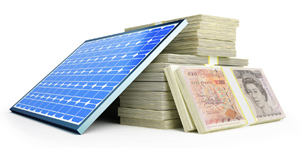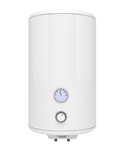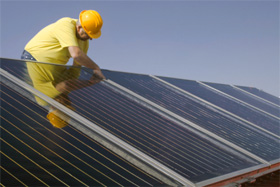Solar panel need-to-knows
 "Solar power? Hang on, we don't live in California!" Yet it's all about daylight, not sunshine, so panels can still generate some electricity on gloomy days - vital when the weather's as dull as watching Steve Davis watching paint dry.
"Solar power? Hang on, we don't live in California!" Yet it's all about daylight, not sunshine, so panels can still generate some electricity on gloomy days - vital when the weather's as dull as watching Steve Davis watching paint dry. Yet before you stick them on your home, understand these key need-to-knows.
- Want solar panels? How to install
Install solar panels and you get paid a 'feed-in tariff' for the energy produced, even if you use it yourself. The tariff you get depends on when your panels are fully installed and registered. Once you've done that, your rate's guaranteed for 20 years.
Full feed-in cuts info
Here's how the installment process works...
- Step 1: Find an installer.
Call local installers to get the best price. Both the system and the installer should be members of the Microgeneration Certification Scheme (MCS). Get at least three quotes before deciding. - Step 2: Get them installed.
Installation typically takes one or two days, roughly two to four weeks after booking, depending on the installer. - Step 3: Register for feed-in payments.
Once panels are in, the installer will send you an MCS certificate. You then register for feed-in payments with your energy supplier to get the current feed-in payments.
Send a completed application form with the MCS certificate, Energy Performance certificate, proof of purchase and ID. Sometimes you can ask your installer to email these documents to you, so you can forward them to the supplier. They can also be sent by post.
Call your supplier to check it's got the application. Write down the date, time and who you spoke to.
- Step 1: Find an installer.
- You need a south-facing roof
You usually need a roof that faces roughly within 45 degrees of south, with no shade from other buildings or trees. While some early or late shading is okay, the roof should be unshaded between 10am and 4pm. If your roof doesn't fit this criteria, you may not be able to get maximum payments with solar panels. - You save on electricity bills
The Energy Saving Trust estimates a typical 4kWp system can knock £130 off a family's bills each year (this is based on typical usage and will vary depending on how much time is spent at home). Electricity prices are predicted to rise massively over the next 20 years, which means the amount you'd save would as well.
The savings depend on the system size, electricity use, whether you're at home during the day and other factors. - Panel prices have dropped
The Government may have slashed payments for generating electricity, but the price of a typical (4kWp) solar panel system, including installation, has dropped to about £7,000 (£6,000-£6,500 in some cases). A system this size used to cost £10,000 to £12,000.
So while the feed-in's less each year, getting panels has become cheaper. See our full analysis - should I buy solar panels? - You may be able to get solar panels free
If you live in certain parts of England and have a suitable roof, a company may offer to fit panels free. In return, it keeps the feed-in tariff cash. You just get the £130ish electricity savings (though energy prices are predicted to rise).
It's tough to meet the eligibility creteria, though, and these deals are getting rarer now the feed-in tariff is being cut. To check if it's right for you and what to watch out for, see Free panels.
Quick questions
How exactly do solar panels work?
Do I need to live in a sunny area?
Who pays the feed-in tariff and how often?
Should you buy solar panels?
 If you've £7,000+ knocking about, you could get some of this back in electricity savings and feed-in payments for the energy you produce.
If you've £7,000+ knocking about, you could get some of this back in electricity savings and feed-in payments for the energy you produce.The key to all this is that with the current feed-in tariff:
A typical system costs £7,000, but over 20 years, the feed-in payments and electricity savings could add up to roughly £16,000.
Solar panels used to be a no-brainer. When the Government launched the feed-in scheme, people typically got a gobsmacking £1,100+ per year in payments. The cash was guaranteed for 25 years, so that was at least £27,500 back - not taking into account electricity savings.The Government slashed these payments so now £630 a year is typical (at current feed-in rates), rising with inflation. Payments are now only locked in for 20 years, paying out £13,000 in total.
At the same time, solar panel prices have dropped. A typical system now costs around £7,000 rather than £10,000.
The cost-to-return ratio is less attractive now and it's far from a guaranteed win at this level, though there are, of course, environmental benefits. You should do your sums carefully and explore other options, for example Top Savings accounts.
Who is this best for?
Ideally, you'll be planning to stay in your home for a few years to recoup some of the cost, though buyers may be attracted by electricity savings and feed-in payments.Whether it's right for you depends on system size, location, whether you're at home during the day and other factors. Use the Energy Saving Trust's Solar Panel Calculator to estimate the gain or call it on 0300 123 1234 for more advice.
You also need an Energy Performance Certificate of grade D or above to qualify for full payments. The Government estimates about half of all properties qualify.
If your home doesn't make Grade D, it may not be worth it - typical payments on the current feed-in tariff would be just £340/year.
Quick questions
How much can I earn via the feed-in tariff payments?
Can the Green Deal help pay for solar panels?
Will the feed-in payments definitely last for 20 years?
How can I make the most of solar panels once I've got them?
How do I pick a fitter?
Solar panel fitters: Don't be fooled
What happens if I sell my house?
Can I change electricity providers?
What if the solar panels break?
Do you need planning permission?
Can you get free solar panels?
It's possible to find companies that offer to fit panels worth £7,000 for free. However, you don't get paid - they keep the lucrative feed-in tariff. So if you have £7,000 knocking about, you may be better off buying panels yourself.With free panels, you still get the £130ish per year electricity savings (as calculated by the Energy Saving Trust). By setting your appliances to use energy during daytimes you can increase this sum, plus prices are predicted to rise hugely over 20 years, which means your savings will rise too. Another bonus is that the firms maintain the panels and pay for insurance.
Before the payments to generate electricity were cut, there were a lot of free solar panel companies. Now many have pulled out, and it can be harder for some to get free panels.
We've listed one free provider below - there are a few other smaller companies which also do the same, but we haven't been able to check them out.

Free solar panels for homeowners across much of England
A Shade Greener*
A Shade Greener* has fitted free panels to over 40,000 homes to date. Panels are fitted free under the government's FIT Scheme which launched in 2010 as a way to encourage people to use more renewable energy.
Who is eligible? A Shade Greener covers much of England - you can see a map of the areas it covers (excludes Scotland, Northern Ireland and most of Wales). It doesn't routinely cover London, the South East, East Anglia or Cornwall, though if you live there it advises you apply anyway to see if you qualify.
You need to own your home, or get the permission of the homeowner if you rent. Your roof must usually be around 24 square metres facing due south, or within 55 degrees of south. Maintenance is included and A Shade Greener pays for the insurance - the company also says it will fix your roof in the event it is damaged by the panels.
Is it any good? It has some good feedback from forumites and there are no charges at all, even if you need non-standard scaffolding. It also insures you, so repairs won't cost you a penny. A Shade Greener also says it has never had an insurance claim. But once you sign up, you'll need to agree to a 25-year lease. You can't buy the panels, but after 25 years, they are yours to do what you like with. Or you can ask A Shade Greener to remove them which they'll do free of charge.
How much can you save? According to A Shade Greener, its customers often save much more on their bills than the £130 the Energy Saving Trust says is typical for solar panels in an average household.
The Energy Saving Trust bases its estimate on users consuming 25% of the energy they generate. A Shade Greener says its users consume a higher proportion and claims they save an average of 37% a year on their electricity bills, with a quarter saving as much as 50%. However, these figures are from research carried out in 2011 - A Shade Greener wasn’t able to provide more recent figures.
How does the company make money? As with other companies offering free panels, A Shade Greener gets to keep the feed-in tariff. It also says the business has up to £380 million in funding from pension companies and investors and is financially in good shape. It has fitted around 45,000 systems in total and is currently making around 350 installations each week.
What happens if I move? The panels and the 25-year agreement for them stay with the property - there's no buy out clause. It doesn't affect mortgages or re-mortgages though - mortgage providers can terminate the lease at anytime thanks to a break clause in the agreement.
Who is eligible? A Shade Greener covers much of England - you can see a map of the areas it covers (excludes Scotland, Northern Ireland and most of Wales). It doesn't routinely cover London, the South East, East Anglia or Cornwall, though if you live there it advises you apply anyway to see if you qualify.
You need to own your home, or get the permission of the homeowner if you rent. Your roof must usually be around 24 square metres facing due south, or within 55 degrees of south. Maintenance is included and A Shade Greener pays for the insurance - the company also says it will fix your roof in the event it is damaged by the panels.
Is it any good? It has some good feedback from forumites and there are no charges at all, even if you need non-standard scaffolding. It also insures you, so repairs won't cost you a penny. A Shade Greener also says it has never had an insurance claim. But once you sign up, you'll need to agree to a 25-year lease. You can't buy the panels, but after 25 years, they are yours to do what you like with. Or you can ask A Shade Greener to remove them which they'll do free of charge.
How much can you save? According to A Shade Greener, its customers often save much more on their bills than the £130 the Energy Saving Trust says is typical for solar panels in an average household.
The Energy Saving Trust bases its estimate on users consuming 25% of the energy they generate. A Shade Greener says its users consume a higher proportion and claims they save an average of 37% a year on their electricity bills, with a quarter saving as much as 50%. However, these figures are from research carried out in 2011 - A Shade Greener wasn’t able to provide more recent figures.
How does the company make money? As with other companies offering free panels, A Shade Greener gets to keep the feed-in tariff. It also says the business has up to £380 million in funding from pension companies and investors and is financially in good shape. It has fitted around 45,000 systems in total and is currently making around 350 installations each week.
What happens if I move? The panels and the 25-year agreement for them stay with the property - there's no buy out clause. It doesn't affect mortgages or re-mortgages though - mortgage providers can terminate the lease at anytime thanks to a break clause in the agreement.
What to watch out for with free solar
Your home is your most valuable asset, so think very carefully about what it means to sign up for a 25-year commitment. Don't read this as a "don't do it". It's a "be prepared that if you do it, it may not be plain sailing".Read these key free solar panel points
Check with your mortgage provider
Ask the right questions
Check your contract carefully
You are signing up for a contract for two and a half decades
What if the free solar company went bust?
Roof repairs can be tricky
Crucial tips to save £100s on energy bills
 Solar panels are a big move. First, ensure you're on the cheapest energy tariff and do the energy-saving basics.
Solar panels are a big move. First, ensure you're on the cheapest energy tariff and do the energy-saving basics.Switch energy provider
Ditch and switch energy provider and you can save £100s each year. Our Cheap Energy Club checks you're on the cheapest deal and if you're not tells you the best deal. Plus we'll keep monitoring your tariff and the market to ensure you're always on the cheapest deal. To encourage you, there's usually up to £30 extra if you switch gas and electricity via the club.It's the same gas, the same electricity, the same safety. All that changes are the customer service and the price you pay. Normally, switch and you risk the provider hiking prices, or giving you a cheap deal for 18 months then ramping costs. So every month, without you doing anything, we do a comparison for you, and alert you when it's worth switching again.
Can you switch energy with solar panels?
Yes. You don't have to get your electricity supply and feed-in tariff from the same company. That means solar panel users can switch freely on Cheap Energy Club, just like everyone else. After switching, payments still come from the current feed-in tariff provider, so nothing changes.If you want to switch to a different company that pays you the feed-in tariff, contact your feed-in provider to see if it's possible. Usually, if you want to get the payments from a different supplier, you'll have to switch energy to that company too. As feed-in payments are fixed and therefore the same across every provider, it may not be necessary.
At application stage, you can't choose a feed-in provider you want, you have to get the feed-in payments from your current energy supplier. A full list of feed-in tariff providers - or 'licensees' - is on Ofgem's website.
There are more ways to cut energy costs, such as always paying by direct debit, which shaves £100 or up to 8% off your annual bill. For a full list of tips, see Cheap Gas and Electricity. If you're on Economy 7, you can slash costs even further by using storage heaters, washing machines and dishwashers through the night. See our Economy 7 guide for full info.
Free insulation and boilers
The big energy providers are giving wads of freebies to people on benefits, from new boilers to insulation. It's because they have to help certain groups save energy.New boilers alone typically cost £2,300, so this is a fantastic freebie. A boiler is a big contributor to your energy bill - so the more efficient your boiler, the more heat it produces from each gas unit.
Depending on its age, a shiny new efficient one could save you up to £300/year. (These figures may be revised in March.)
Wall and top-up loft insulation can slice up to £160 off energy bills per year. You could qualify if you get tax credits or income-based benefits, such as pension credit or income support.
To speedily uncover these crocks of gold, including a rundown of current offers, see the Free Boilers and Insulation guide. Also see Home and Energy Grants for a full list of hidden cash.






 As we're MoneySavers, not electricians, picking installers isn't our speciality.
As we're MoneySavers, not electricians, picking installers isn't our speciality.
Here's how to cut your power bill up to 75%:
ReplyDeleteWant to know how to easily produce all of the renewable energy you could ever want right at home?
And you will be able to make your home totally immune from power failures, blackouts, and energy grid failures…
so even if everyone else in your area (or even the whole country) loses power…you won’t.
VISIT THIS SITE: DIY HOME ENERGY
I’m very happy that I choose to go with solar panel, solar is the thing for the future, the sun is free we should use it.
ReplyDeleteInstalling A Solar Panel
Solar Pool Heating
Solar Las Vegas
Solar Power Installation Companies